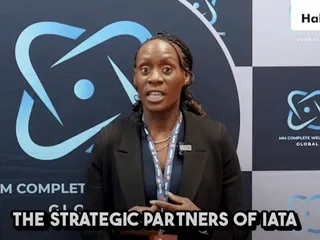FAA and EASA: Similar, But Different
Contact Our Team
For more information about how Halldale can add value to your marketing and promotional campaigns or to discuss event exhibitor and sponsorship opportunities, contact our team to find out more
The Americas -
holly.foster@halldale.com
Rest of World -
jeremy@halldale.com

Ten years on from the introduction of upset prevention and recovery training, UPRT this year becomes a mandate from the FAA and EASA. But there are differences in their requirements, Mario Pierobon reports.
UPRT becomes part of mandatory training required for flight crews in 2019 – as of March in the United States, as of December in Europe.
The concept of upset prevention and recovery training was first introduced in 2009 as an improvement to the previous ‘unusual attitude training.’ And though crew training requirements are developed internationally, some distinctive peculiarities may arise when they are embedded into national or transnational requirements. Such is the case for UPRT under the US Federal Aviation Administration (FAA) and the European Aviation Safety Agency (EASA) frameworks.
EU UPRT, US Extended Envelope
Under EASA, UPRT requirements apply to all operators of “complex motor-powered aeroplanes.” In the US, these new elements of training are instead referred to as Extended Envelope Training, on the premise that there are valuable prevention skills that can be learned in the extended envelope that are not upsets per se and apply to scheduled air carriers. “Extended envelope training is addressed in 14 CFR part 121.423. Additional rules on ground training are in 14 CFR parts 121.419 and 121.427. Training for flight instructors and check pilots are in 14 CFR part 121.413 and 121.414,” notes Dr. Jeffery Schroeder, chief scientific and technical advisor, Flight Simulation Systems at the FAA.
FAA extended envelope training requirements took effect on 12 March 2019. FAA requirements apply only to domestic, flag, and supplemental operations under 14 CFR part 121. “Broadly speaking, those rules cover scheduled air carriers, both regional and major airlines. Helicopters operations fall under parts 133 and 135, rather than the part 121 regulations for scheduled air carriers. Public Law 211-116, Section 208, was a statute that required stall and upset recognition and recovery training for part 121 air carriers, which the FAA fulfilled. While it is possible that extended envelope training may be broadened someday beyond part 121 operations, that decision has not been made,” Schroeder told CAT.
There is also a difference between the FAA and EASA regulatory frameworks in relation to the categories of aircraft operations, explains Nick Leontidis, group president, Civil Aviation Training Solutions at CAE: “Currently the FAA only mandates UPRT training for both initial ATP candidates in accordance with 14 CFR 61.156 (Advisory Circular AC 61–138) as well as the extended envelope training requirements mandated under 14 CFR 121.423. Although the UPRT requirements associated with extended envelope training only apply to air carrier operations under 14 CFR 121, the FAA encourages all operators and flight schools to implement UPRT training in accordance with advisory circular AC 120–111.”
The scope of EASA is different indeed. “Operators of complex aeroplanes are required to carry out UPRT. This has a much broader impact and hence, whatever is mandated applies to the operators of all complex aircraft, small to large,” says Dr. Sunjoo Advani, president of International Development of Technology in The Netherlands and founder of the International Committee for Aviation Training in Extended Envelopes (ICATEE), which initially defined the requirements for UPRT.
AURTA, the Foundation
Most of the requirements are the same under both EASA and the FAA, as they are based on the Airplane Upset Prevention & Recovery Training Aid (AURTA) published by the International Civil Aviation Organization (ICAO), points out Suren Meras, senior director, Operations at FlightSafety International: “The FAA requires a set of extended envelope items to be trained that include manually controlled slow flight, manually controlled loss of reliable airspeed, manually controlled instrument departure and arrival, upset recovery manoeuvres, recovery from bounced landing, and instructor-guided hands-on experience of recovery from full stall and stick pusher activation.”
By comparison, he adds, “EASA requires additional training items that include manual flight with and without flight directors, manual flight at different speeds (including slow flight) and altitudes, manual procedural instrument flying and manoeuvring including instrument departure and arrival, and visual approach, recovery from stall events in different configurations, upset exercises and rejected landing with all engines operating after touchdown (baulked landing).”
Leontidis notes that in regard to ab initio training within EASA, the Agency has introduced a crew training regulation which comprises advanced on-aircraft UPRT for the Multi-crew Pilot Licence (MPL) course and the Integrated Airline Transport Pilot (ATP)(A) course, in addition to basic on-aircraft UPRT for the Commercial Pilot License (CPL)(A) course, and makes it a prerequisite for completing a class or type-rating course. These requirements came into effect in December 2018 and will become mandatory from December 2019.
“CAE is currently working to update its programmes to comply with these requirements. For ab initio within FAA-regulated countries, the administration does not have any requirements for on-aircraft UPRT under its Part 61 or Part 141 regulation. For EASA type-rating training, these requirements are also covered under crew training regulation. For FAA type-rating training, UPRT requirements are included in the Part 121 extended envelope training requirements,” he notes.
Advani highlights that an important aspect to consider is that a full aerodynamic stall or an approach-to-stall are both ‘stall events.’ “The recovery from either is identical, i.e. by reducing the angle of attack. However, the full-stall training, as required under FAA rules, dictates that the simulator must be qualified beyond the approach-to-stall region. This has training value in terms of exposing the pilot to the escalation to the full stall, and the recovery from that stall. However, it also places a burden on the infrastructure and the training required,” he says. “For operators of smaller aircraft, and since there are multiple regions around the world that literally follow EASA’s provisions, it could be very challenging to mandate the modification of all simulators. Moreover, it is likely that in the future all simulators will come equipped with full-stall capability. It is a matter of time. It is felt though that the greatest impact can already be achieved by training the approach-to-stall today and, again, knowing that the recovery – reducing angle of attack first – is always the same.”
A key word to all UPRT is ‘recognition.’ “If this is taught properly, there is a good chance the pilot will apply the right skills to identify the problem correctly, followed by the application of the correct technique or procedure. No matter how elaborate the simulator is, this remains the critical component of the UPRT training programme,” says Advani.
Trainer/Training Organisation Guidance
There are differences between the FAA and EASA also with regard to the role of the trainer and the training organisation. “FAA requirements for check airmen and instructors are given in part 121.413 and 121.414. Guidance for meeting these trainer requirements is provided in Advisor Circular 120-111. Airlines operating under 14 CFR part 121 are responsible for their own training program if they use a training centre,” says Schroeder.
Meras notes that EASA has provided guidance material that discusses how to train the additional items related to type-specific UPRT and go-around training in simulators. “This guidance material discusses stall events, nose-high and nose-low recovery exercises, and go-arounds from various stages during an instrument approach,” he says.
According to Advani, the main differences regard the actual implementation. “Regulations are not, and should not, be overly prescriptive. They define the required ingredients. Carriers or operators should develop their course content based on their airline’s specific needs (prior training given to pilots, fleet, pilot demographics, applicable regulations, etc). Some operators choose to develop programmes internally. All programmes include training profiles that cover the rules, while others elect to go further, emphasising certain issues until the pilot has thoroughly mastered that concept,” he says. “An example is training ‘angle-of-attack management.’ It is listed in regulations; however, it may take several exercises to thoroughly understand how it relates to your safety margins.”
“More in Common”
There are indeed UPRT differences between the two major aviation regulatory agencies, but their implications are the same as for any other international difference. “For permitted operations in the United States, inspectors under the FAA’s International Air Safety Assessment programme determine if a country and its airlines meet ICAO international standards. If a country fails that assessment, airlines from that country cannot fly into the United States. The FAA was part of the development of the ICAO international standards. The FAA completed and published extended envelope training regulations in 2013,” says Schroeder.
Indeed, pilots are licensed to the state where the aircraft is registered. “EASA and FAA regulations generally develop the regulation to address the specific safety issues in their respective systems. Except for the highlighted differences, the two have more in common than differences,” says Leontidis.
“Right now we are not aware of any implications on pilots flying internationally who have not completed any UPRT training events. We believe there will become a time when the FAA updates the AC to include Part 135 operators into the requirements to train UPRT elements but that will be in the future. We think this convergence will happen but are not sure when the rulemaking will occur for it,” says Meras.
“One of the challenges in making the convergence for the 135 operators,” Meras explained, “is that simulators will need to be upgraded to fall in line with FAR 60 Directive 2. This could be difficult as there are a number of aircraft that are out of production that we would need to get flight test data from the OEM or a vendor to be able to certify the simulator to accomplish the extended envelope training that is defined in the FAA AC and regulations. EASA is ahead of the game with this as they are requiring all pilots holding a type rating to undergo UPRT training starting 20 December 2019 and as such, all simulators need to be compliant with CSFSTD(A) Issue 2 by this date.”
“The requirements as far as training are very similar. Under both the EASA and FAA requirements, the recognition of an upset or stall event predominates. Prevention is the main priority. If prevention fails, then recovery must be executed to prevent a loss-of-control situation,” concludes Advani. “If we simply go back to teaching ‘attitude recoveries,’ we will be going back a decade. UPRT is about integrating basic manual flying skills with proper procedures and learning to maintain suitable safety margins. Recognition before reaction makes a massive difference to safety.”
Published in CAT issue 3/2019


